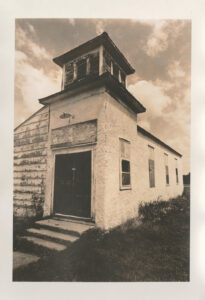
August 2023 Newsletter
I want to talk about the Paseo Photofest. This juried competition takes place at the Paseo Arts and Creativity Center, the blue building on the southeast corner of Paseo Drive and NW 30th St every September. This year’s jurist is Mark Zimmerman, an Associate Professor at University of Central Oklahoma in Mass Communications and multiple award winner. I know many of you are photographers in your own right and I encourage you to enter using this link: https://www.thepaaok.org/upcoming-paa-events/call-for-entries-paseo-photofest
Entries are due August 7th and everything you need to know is on the application page.
As proof that my money is where my mouth is, I have submitted three entries for consideration. But before I talk about the images, I want to discuss a unique process I used for them. They have in common the developer I used in the darkroom, a developer called “lith.” This developer has a different chemistry that gives some black and white papers a warm tone to the highs and middle tones that can range from a warm yellow to red or salmon color. This developer also works by an “infectious” development that causes the shadows to have a grainy black appearance. Very few modern papers will react favorably to this developer so I reserve the papers I have that work with lith for use only with this process.
Now for my entries:
Fort Supply Refuge

This is an old stucco sided church in the northwestern Oklahoma town of Fort Supply that captured my attention because of the carved wooden door, and its overall good condition. This church struck me as having a certain dignity; it may no longer have an active congregation to love it, but it still bore witness to the town’s spiritual life. Unfortunately, the wooden siding is now missing and it just looks tired; I haven’t mustered the courage to print the few negatives I’ve made since this one. The salmon pink tone and grainy texture of this image is a result of development in lith but if you look carefully, you’ll notice cool blue tones in the sky, the grasses and the wood of the steeple. To get this effect, the print was partially toned in selenium until the tones split.
Nobody's Home

This abandoned home in Fairbury Nebraska was interesting to me because of the open screen door with its little spindles that are mirrored in the porch posts. Those rounded shapes are juxtaposed against the strong horizontals and verticals in the siding, and the strong triangle of shadow across the porch wall creates an interesting diagonal shape and a region of strong contrast. You can see the grainy texture from lith development in the grasses and roof shingles but the salmon paper tone has been replaced with a tonal split of warm browns from selenium toning and purples from gold toning. The wood siding looks almost velvety in this print and this combination of developer and toners is one of my favorites.
Blobe Mallows

My third entry is this floral macro of a flowering plant ubiquitous along the roadsides and trails of Oklahoma and the west. In western Oklahoma, these little guys are typically only a couple inches tall and the flowers a half inch or less in diameter. The flowers are a light pinky orange that is close to the colors one gets from lith developer on some papers. I took advantage of infectious development in this print to push the background all the way to black so the flowers were in high contrast. Some of the flowers have been oil tinted with Marshall’s Oils to deepen the orange tone of the flower and cool the middle flower sections with blue.
I am still working out the most effective uses for oil tinting and painting over black and white photography but this exploration has been extremely rewarding.
I hope you’ve enjoyed reading about my entries to the Paseo Photofest and learning about some of the interesting chemistry available to the darkroom photographer to broaden his or her creative possibilities.